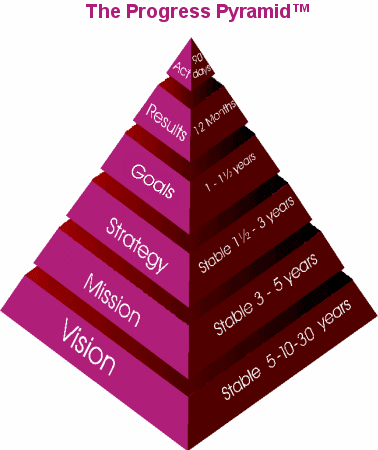Strategies for Organizations
Use strategic planning to create your future
Strategic planning is creating a vision of the future and managing toward that expectancy. It's operating under a vision, mission, and strategy umbrella that focuses the organization's effort. It's an effective process for aligning your short-term decisions with your long-term goals.
Strategic planning answers the four big questions:
- Where are we today?
- Where do we want to be in the future?
- What should we be focused on today, in order to make it more likely we will be where we want to be in the future?
- How do we make it happen?
It is a simple process with an incredible power to energize your organization and bridge the gap between long-term vision and day-to-day tactics. One way to visualize the process is as a pyramid, with vision forming the stable base and rapidly evolving tactical action steps at the top.
Properly done, the strategic planning process customizes itself around the unique issues of each organization.
Strategic planning makes an immediate impact
- It builds true teamwork by developing consensus, commitment, and trust.
- It delivers dramatically higher results by establishing personal accountability, specific measures and action steps, a commitment of team members and company resources, and a stable investment platform.
- It reduces stress through a shared vision, mutual trust, and tools for effective delegation.
Strategic planning can keep the organization from being overcome by events
- It provides regular “stakes in the ground” meetings that force the leadership team to reevaluate where they are relative to where they want to be and whether their action plans are changing the status quo quickly enough.
- It provides a quarterly forum for recognizing opportunities/threats and developing responses with appropriate urgency.
- It provides a forum for discussions and resolution of issues that don’t lend themselves to operational meetings.
Strategic planning strengthens the leadership team
- It forces the leadership team to think about the big picture - look at the business through the eyes of the CEO
- It helps team members communicate with and listen to one another's fears, insights, and dreams.
- It makes everyone focus on what is truly important to the organization, prioritizing efforts and the use of resources.
- It gets the team on the same page - a shared visualization of where the organization wants to be within 5, 10 or 30 years.
- It results in proactively changing the status quo with an implementation process that keeps people on schedule, on track, and regularly held accountable for 30-, 60- and 90-day action steps.
What's the Quickest Path to these Benefits?
Since 1991, organizations have been discovering that Myrna Associates' strategic planning process is the secret path to success. They have found the "Myrna magic" to be a powerful and an affordable tool for coping with major transitions ranging from near bankruptcy to sudden, massive, and uncontrolled growth.
Our strategic planning services are the quickest, most reliable way to turn the concept of strategic planning into reality. It is a proven process, professionally facilitated, with prompt delivery of the documented plan
We offer a selection of Services that caters to every need.
Contact Us
Contact us today to arrange for a
COMPLIMENTARY CONSULTATION
to determine if the program is a right fit for you.
Contact us Today!
800-207-8192
or email us on
success@myrna.com

